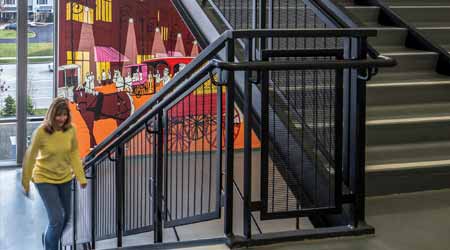 Promoting physical activity through design can encourage movement. The American Greetings headquarters outside of Cleveland has centralized the stairways and visible circulation paths to get employees up and moving.© CallisonRTKL/David Whitcomb
Promoting physical activity through design can encourage movement. The American Greetings headquarters outside of Cleveland has centralized the stairways and visible circulation paths to get employees up and moving.© CallisonRTKL/David WhitcombOccupant Health and Wellness Takes Center Stage in Sustainable Design
A more thoughtful approach to how buildings influence those who occupy them has many tangible benefits, both financially and for the health and wellness of occupants.
Traditionally, sustainability has been measured in terms of metrics like energy efficiency and carbon emissions. Programs like LEED have become popular due to their quantifiable approach to energy efficiency, and green design has become synonymous with building performance. While high-performance buildings are an important step toward sustainability, facility managers and interior designers are beginning to think more critically about space, and how it impacts human health. A growing body of research outlines the relationships between humans and the environments they inhabit, with a strong correlation between our surroundings and how well we feel. Examining this correlation has led to an explosion of interest in workplace well-being.
Systems like WELL and Fitwel are enabling a more thoughtful approach toward designing for sustainability and human health. When it comes to sustainable design, many facility managers and designers are already using best practices: selecting energy-efficient fixtures, leveraging natural light, and selecting sustainably sourced and low-emitting materials. To supplement sustainable best practices, it’s helpful to understand and quantify the impact of design interventions on human wellness in the interior environment.
Multiple payoffs
Many common workplace issues are tied directly to occupant well-being, and addressing these issues through design and operations can directly affect occupant engagement, satisfaction, and productivity. For example, air quality (including ventilation rates, airflow, and concentrations of pollutants) impacts cognition and decision-making capabilities, so increasing ventilation rates and decreasing pollutant concentrations can have a measurable benefit on occupant effectiveness, productivity, and performance. A space that is too hot, cold, humid, or stuffy can pose a threat to productivity, so providing adjustability and monitoring interior conditions can support employee engagement and productivity.
Perhaps one of the best-known issues impacting human health is the prevalence of sedentary behavior among office workers. The negative impacts of prolonged sitting are well-known and include risks of cardiac disease, high blood pressure, and diabetes. Promoting physical activity in the workplace through design can go a long way toward encouraging movement — think centralized stairways and visible circulation paths to get occupants up and moving. In addition to movement, ergonomics is a fundamental part of physical well-being. Providing ergonomic furniture (along with training and education) can increase engagement and productivity, while decreasing the long-term risk of injury or pain.
One common complaint of employees (especially in open work environments) is noise level; noise can be extremely distracting, posing a threat to concentration and productivity. While interior noise levels themselves are often not high enough to damage hearing, prolonged background noise can have non-auditory effects. Exposure to noise can increase the risk of stress-related responses and can increase the likelihood of cognitive withdrawal. Providing a variety of both open and enclosed spaces can decrease acoustical disruption and designing with absorptive materials and sound masking can mitigate noise and its associated effects.
Beyond providing appealing views to the outside, windows support health and well-being through access to daylight. Natural light allows occupants to synchronize circadian rhythms to support alertness, sleep quality, and mood, all of which can positively impact productivity. Interior lighting should also be provided to supplement light levels, decreasing the risk of eyestrain, headaches, and fatigue. Adjustable lighting levels can increase occupant engagement and prevent glare while maintaining sufficient brightness for daily tasks.
In addition to physical health, mental, and emotional health are important components of overall well-being. Stress is often an inextricable part of the workplace, causing damage to work/life balance, productivity, and employee satisfaction. While it’s probably unrealistic to eliminate stress entirely, healthy workplace policies (taking vacation and reducing off-hours emailing) and stress relief through yoga and meditation can support mental health. The design of the workplace can also mitigate stress: Including a variety of open and enclosed spaces allows employees to see their surroundings, while still providing areas of retreat to reduce feelings of exposure.
Related Topics:















